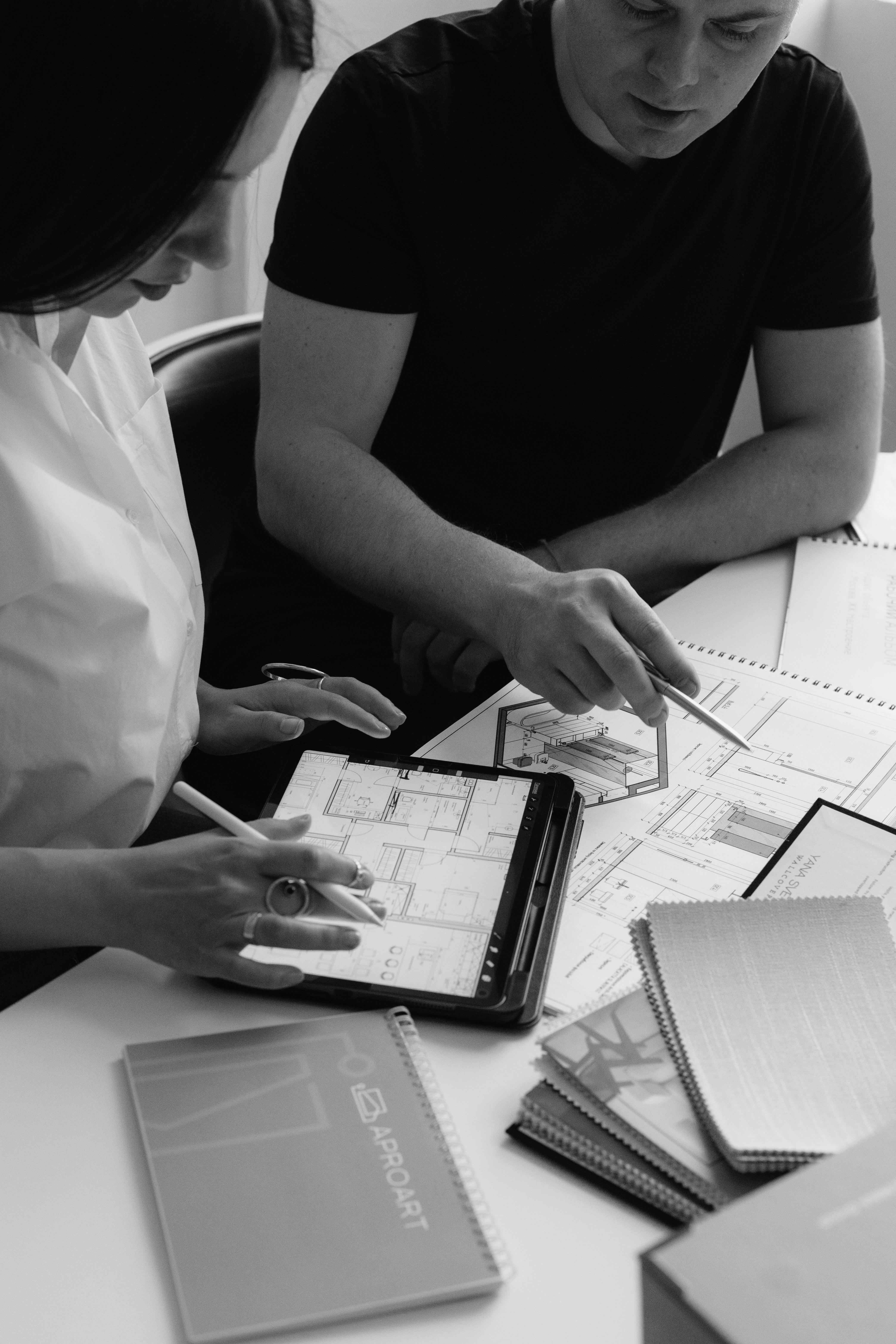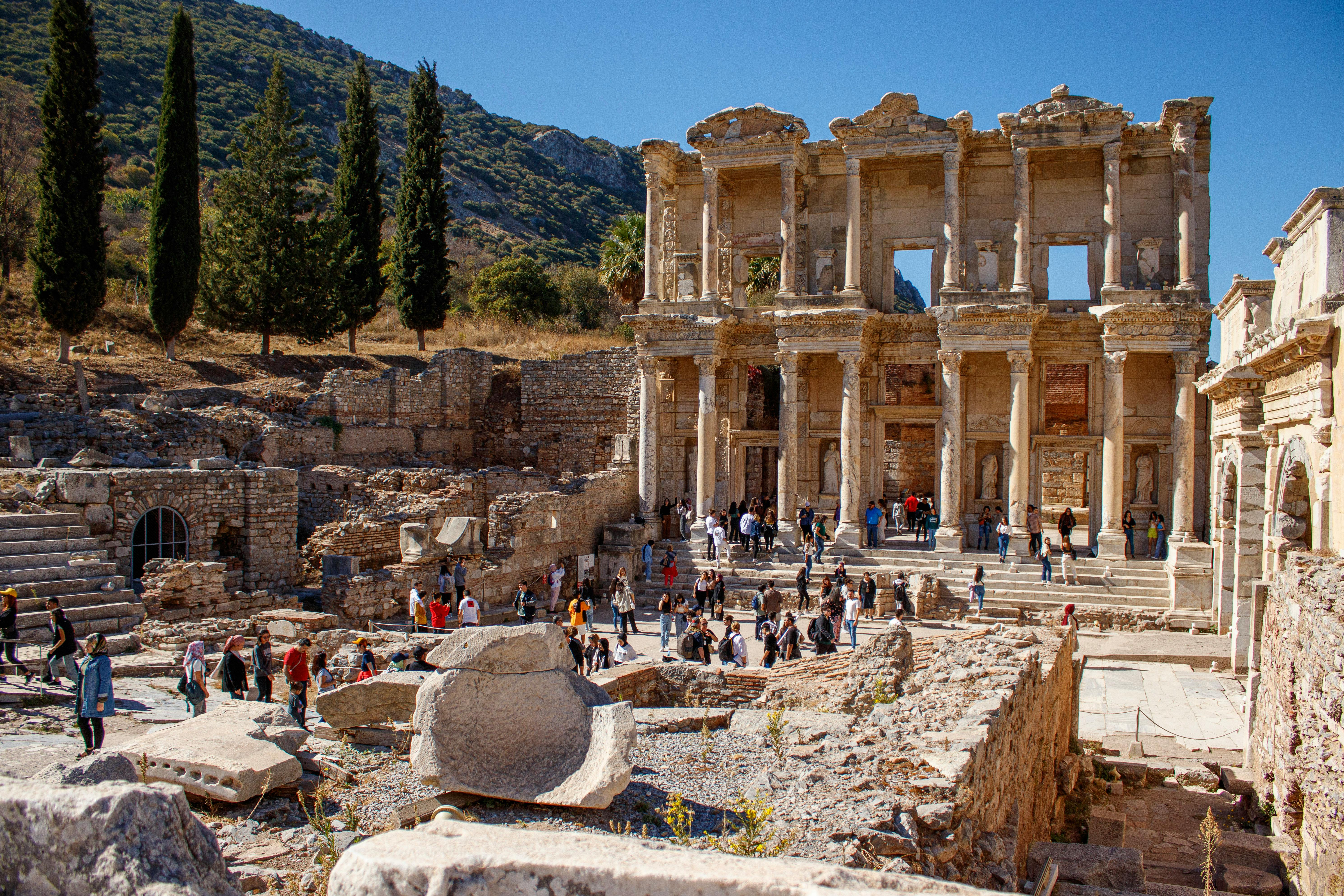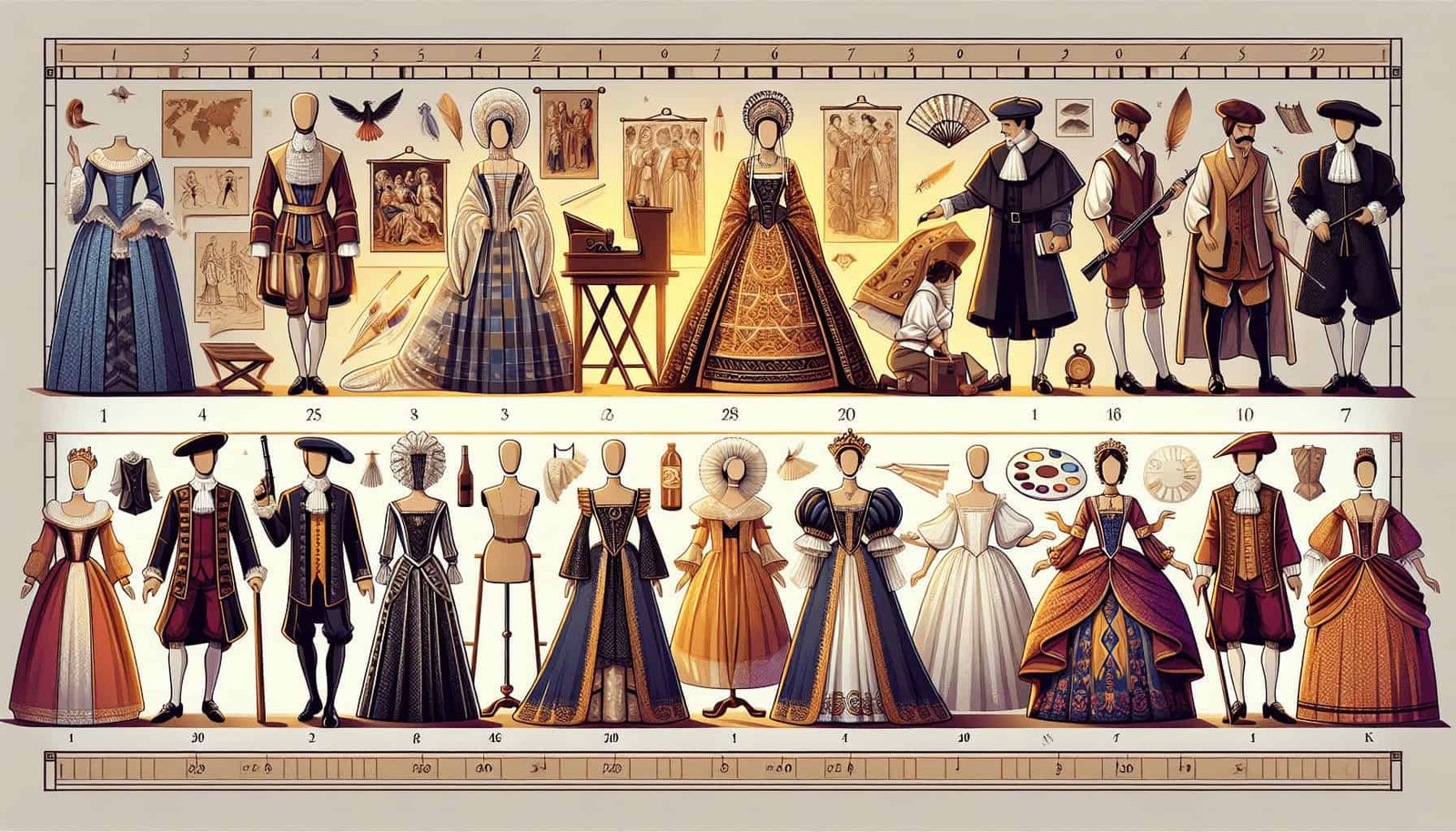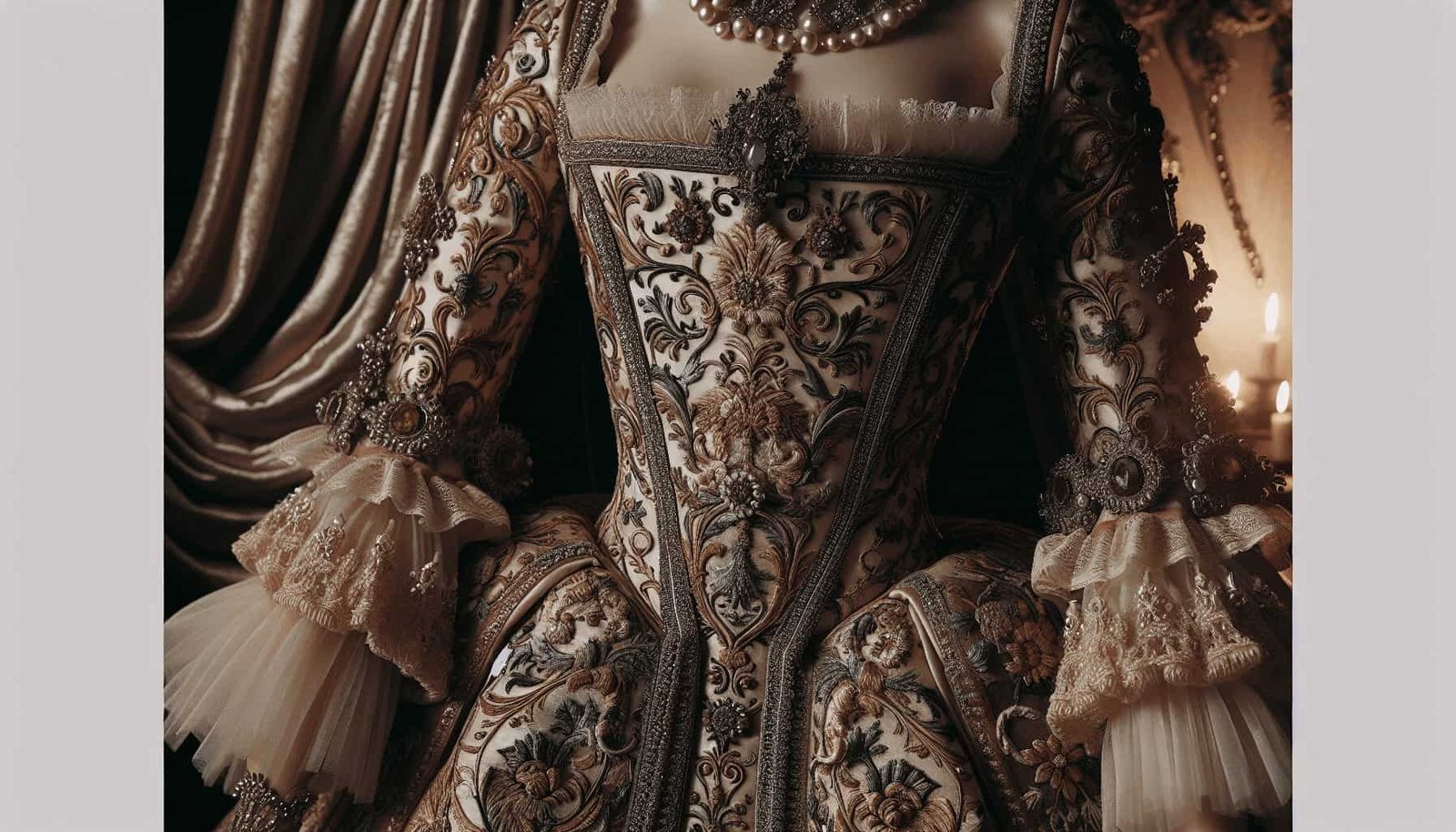Imagine stepping back in time and witnessing the exquisite beauty of historical costume design. From the grandeur of medieval gowns to the intricately embroidered robes of ancient civilizations, the artistry and attention to detail in these garments are simply breathtaking. This article explores the fascinating world of historical costume design, delving into the rich history and cultural significance behind these remarkable works of art. Prepare to be transported through time as you discover the secrets and stories woven into each elaborate stitch.

Definition of Historical Costume Design
Overview
Historical costume design refers to the practice of creating authentic and visually compelling costumes for characters in historical settings, whether it be for theater, film, or fashion. It involves researching different time periods, understanding the social and cultural contexts, and applying this knowledge to design costumes that accurately represent the era. Historical costume designers aim to transport audiences to a specific time and place through their meticulous attention to detail and creative interpretation of historical fashion.
Purpose
The purpose of historical costume design is to enhance storytelling and bring the past to life. By meticulously crafting garments that are historically accurate, costume designers can create a visual language that immerses audiences in the world of the narrative. Whether it’s conveying the opulence of the Baroque period or the austerity of Victorian England, historical costumes play a vital role in establishing the authenticity and ambiance of a production or event.
Importance
Historical costume design is of utmost importance in various artistic fields. In theater, costumes help actors embody their characters and transport the audience to different time periods. In film, historical costumes add credibility and authenticity, ensuring that viewers are fully immersed in the story. From a fashion perspective, historical costume design influences contemporary designers by showcasing the evolution of style and craftsmanship throughout history. It serves as a source of inspiration and allows designers to pay homage to the past while adding their own modern twist.
Evolution of Historical Costume Design
Early Developments
Historical costume design can be traced back to ancient civilizations such as Egypt, Greece, and Rome. In these early civilizations, clothing was a reflection of social status and cultural norms. The draping and embellishments of garments were influenced by art and architecture, as well as practical considerations such as climate and occupation.
Influence of Renaissance
The Renaissance period marked a significant shift in historical costume design. It saw a revival of interest in ancient Greek and Roman styles, as well as the emergence of new silhouettes and fabric technologies. The era was defined by voluminous gowns, intricate detail work, and the use of sumptuous fabrics. Artists like Leonardo da Vinci and Botticelli heavily influenced both fashion and costume design during this time.
Baroque and Rococo Periods
The Baroque and Rococo periods introduced even more opulence and extravagance to historical costume design. Elaborate wigs, corsets, and intricately embroidered garments became the norm for the upper classes. These periods emphasized grandeur and theatricality, with clothing becoming a symbol of status and power. The French Court, particularly under the reign of Louis XIV, played a significant role in shaping Baroque fashion and inspiring costume designers.
19th and 20th Centuries
The 19th and 20th centuries witnessed rapid changes in historical costume design due to industrialization and cultural shifts. The Victorian era was characterized by tightly laced corsets, bustles, and lavish dresses that showcased the wealth and social standing of the wearer. As the 20th century progressed, historical costume design in film and theater became more accessible to wider audiences, with designers like Edith Head spearheading the creation of iconic costumes that are still celebrated today.
Key Elements in Historical Costume Design
Silhouette
The silhouette of historical costumes plays a crucial role in capturing the essence of a particular era. From the hourglass figure of the Victorian era to the broad shoulders and narrow waists of the 1940s, costume designers must understand the cultural and historical context surrounding different body ideals. By manipulating the shape of garments, designers can create visually striking and accurate representations of historical fashion.
Fabrics and Textiles
The choice of fabrics and textiles is vital in historical costume design. Designers must research and source materials that were popular and available during the specific time period they are working on. Whether it be silk for high society gowns or wool for practical everyday wear, the fabric selection helps bring authenticity and texture to the costumes. Understanding the characteristics and drape of different materials is essential for creating costumes that not only look accurate but also feel authentic to the time period.
Colors and Patterns
Colors and patterns also play a significant role in historical costume design. Different time periods had distinct color palettes and patterns that were popular during their respective eras. The bold and vibrant colors of the Renaissance, for example, contrast with the rich jewel tones of the Baroque period. Costume designers must carefully select colors and patterns that evoke the spirit of the time while also considering practicalities such as lighting and the overall color palette of the production.
Accessories
Accessories are the finishing touches that complete a historical costume. From gloves and hats to jewelry and shoes, accessories help to enhance the overall aesthetic and add depth to a character’s look. Historical accuracy is crucial when it comes to selecting accessories, as these small details can make or break the authenticity of a costume. A well-chosen accessory can communicate a character’s status, profession, and personality, further enriching the storytelling experience.
Role of Historical Costume Designers
Research
One of the primary responsibilities of historical costume designers is thorough research. They must study the fashion trends, social customs, and historical events that shaped the era they are working on. This research helps them gain a deeper understanding of the time period and ensures accurate representation in their designs.
Conceptualization
Once armed with research, historical costume designers begin the process of conceptualization. They sketch out initial ideas and explore different visual interpretations of the historical fashion. This stage allows designers to experiment with silhouettes, colors, and fabric combinations, setting the foundation for the final costume designs.
Creation
After the conceptualization stage, historical costume designers start bringing their ideas to life. They collaborate with skilled artisans and craftsmen to construct each garment. This involves pattern-making, cutting fabrics, sewing, and intricate detailing. Costume designers must ensure that each garment embodies both historical accuracy and visual appeal.
Collaboration with Production Team
Historical costume designers work closely with the production team to ensure that the costumes align with the overall vision of the project. They collaborate with directors, set designers, and makeup artists to create a cohesive visual narrative. Costume designers must be open to feedback and make adjustments as necessary to accommodate the needs of the production, while still maintaining historical authenticity.

Challenges in Historical Costume Design
Authenticity vs. Creativity
One of the challenges faced by historical costume designers is striking a balance between authenticity and creativity. While historical accuracy is essential, designers also need to inject their own artistic flair to create visually compelling costumes that capture the audience’s attention. This delicate balance ensures that costumes are both accurate to the time period and visually appealing to contemporary audiences.
Limited Resources
Historical costume design often involves working with limited resources, especially when it comes to finding historically accurate fabrics and materials. Designers must be resourceful and creative in sourcing or recreating textiles that closely resemble those used in the past. Limited budgets can also pose challenges, as designers must find ways to create elaborate costumes within tight financial constraints.
Integrating Performance Requirements
Historical costumes not only need to be aesthetically pleasing but also functional for the performers. Designers must consider the physical demands of the actors and incorporate elements that allow for ease of movement, durability, and comfort. This can be especially challenging when designing costumes for dance performances or action sequences, where flexibility and practicality are paramount.
Famous Historical Costume Designers
Edith Head
Edith Head is considered one of the most influential costume designers in the history of cinema. She won a record-breaking eight Academy Awards for Best Costume Design and was known for her collaborations with Alfred Hitchcock and Audrey Hepburn. Head’s innovative designs and attention to detail made her a pioneer in the field of historical costume design.
Sandy Powell
Sandy Powell is a British costume designer who has garnered widespread acclaim for her work in both theater and film. She has won three Academy Awards and is known for her collaborations with directors such as Martin Scorsese and Todd Haynes. Powell’s ability to balance historical accuracy with imaginative reinterpretations has made her a sought-after figure in the industry.
Jacqueline Durran
Jacqueline Durran is a British costume designer known for her work on period films such as “Pride & Prejudice” and “Anna Karenina.” She has been nominated for numerous awards, including four Academy Awards, and has been praised for her meticulous attention to detail and ability to capture the essence of different time periods through her designs.
Colleen Atwood
Colleen Atwood is an American costume designer known for her collaborations with director Tim Burton and her work on films such as “Alice in Wonderland” and “Chicago.” She has won four Academy Awards and is renowned for her ability to create fantastical and whimsical costumes while still maintaining historical accuracy.

Historical Costume Design in Cinema
Influence on Narrative
Historical costume design plays a significant role in shaping the narrative of films set in the past. Costumes create visual cues that help audiences understand the social hierarchy, character motivations, and cultural context of a story. Whether it’s a lavish ball gown or a rugged period-appropriate ensemble, historical costumes can enhance the storytelling and deepen the audience’s connection to the characters and their world.
Academy Awards
Historical costume design is highly regarded in the film industry and has its own category at the Academy Awards. The Best Costume Design award recognizes the exceptional talent and creativity of historical costume designers. Over the years, many films with outstanding historical costumes have been recognized, further emphasizing the importance and impact of historical costume design in cinema.
Iconic Costumes
Historical costume design has given birth to iconic and instantly recognizable costumes in film history. From the sweeping green gown worn by Keira Knightley in “Atonement” to the indelible image of Marilyn Monroe’s white dress in “The Seven Year Itch,” historical costumes have become iconic symbols of their respective eras and have left a lasting impact on popular culture.
Historical Costume Design in Theater
Character Interpretation
In theater, historical costume design is essential for character interpretation. Costumes help actors physically embody their characters and bring authenticity to their performances. By wearing historically accurate garments, actors can better understand the social status, personality traits, and motivations of their characters, enabling them to create more nuanced and engaging performances.
Practicality for Stage
Historical costume design in theater must also consider practicality for the stage. Costumes need to be designed with quick changes, durability, and ease of movement in mind. Theatrical performances often involve rapid scene transitions and physically demanding choreography, so costumes must be functional without compromising historical accuracy.
Historical Accuracy
Historical accuracy is a cornerstone of historical costume design in theater. Whether it’s a Shakespearean tragedy or a period piece set in the 18th century, the costumes must reflect the fashion and social norms of the time. In-depth research and attention to detail are crucial to ensure that the costumes accurately represent the era and enhance the audience’s understanding and immersion in the performance.

Historical Costume Design in Fashion
Period-Inspired Collections
Historical costume design has a significant influence on contemporary fashion. Designers often draw inspiration from the past to create period-inspired collections that celebrate the craftsmanship and style of a specific era. From runway shows to high-end fashion editorials, historical costume design continues to shape the aesthetic of today’s fashion industry.
Historical Influences
Throughout history, fashion trends have been influenced by historical costume design. Elements like corsets, ruffles, and bustles have made comebacks at various points, showing the cyclical nature of fashion and its connection to historical aesthetics. By studying historical costumes, fashion designers can gain a deeper understanding of the evolution of style and incorporate timeless elements into their modern designs.
Costume Balls and Events
Costume balls and events provide an opportunity for individuals to embrace historical costume design in a fun and imaginative way. These occasions allow people to dress up in elaborate historical costumes and immerse themselves in a specific era or theme. Costume balls celebrate the artistry and creativity of historical costume design while allowing participants to experience the glamour and elegance of the past firsthand.
Education and Training in Historical Costume Design
Studies and Programs
Various educational institutions offer programs and courses in historical costume design. These programs provide students with a comprehensive understanding of historical fashion, pattern-making, textile knowledge, and costume construction techniques. Through hands-on practical experience and academic coursework, students gain the skills necessary to excel in this specialized field.
Skills Required
Historical costume designers require a unique set of skills to succeed in their craft. Attention to detail, an extensive knowledge of fashion history, and the ability to research and source materials are all essential. In addition, strong conceptualization and design skills, as well as proficiency in pattern-making and sewing, are necessary for bringing historical costumes to life.
Internships and Practical Experience
Internships and practical experience are invaluable for aspiring historical costume designers. By working alongside experienced professionals, students and emerging designers can gain hands-on experience in the industry. Internships provide opportunities to learn about costume construction techniques, sourcing fabrics, and collaborating with production teams. Practical experience in historical costume design helps students refine their skills and build a professional network within the industry.
In conclusion, historical costume design plays a vital role in transporting audiences to different eras and enhancing storytelling in theater, film, and fashion. From the early developments of ancient civilizations to the opulence of the Baroque period, the evolution of historical costume design reflects the ever-changing social and cultural landscape of humanity. With attention to key elements such as silhouette, fabrics, colors, and accessories, historical costume designers create visually compelling and historically accurate costumes. Despite the challenges of balancing authenticity and creativity, working with limited resources, and integrating performance requirements, historical costume designers continue to leave a lasting impact on the artistic landscape. Whether it’s iconic costumes in cinema, character interpretation in theater, or period-inspired collections in fashion, historical costume design continues to captivate and inspire audiences worldwide.

